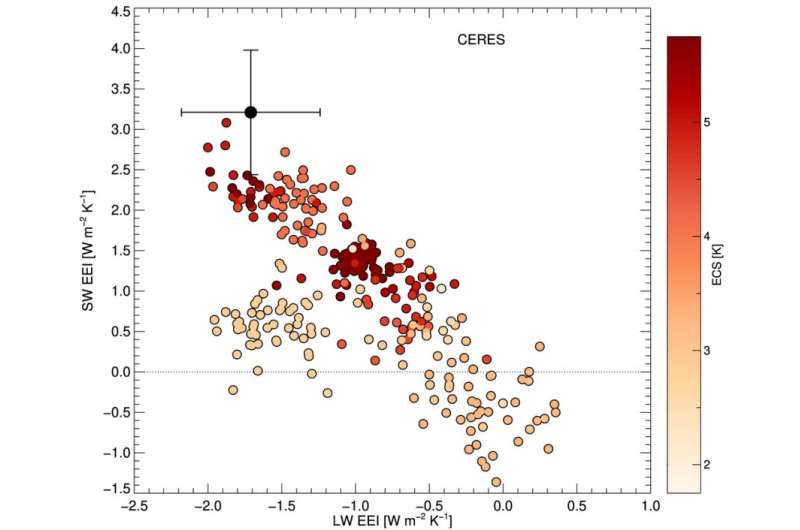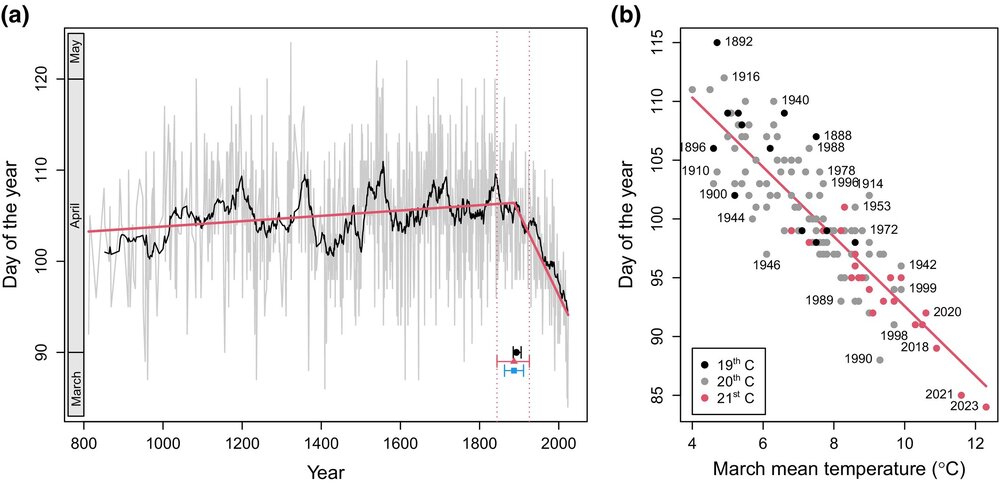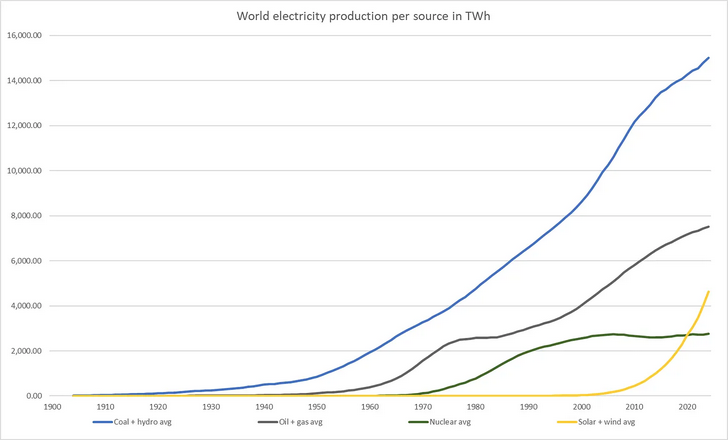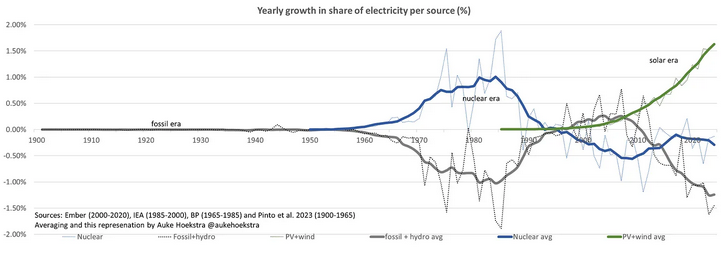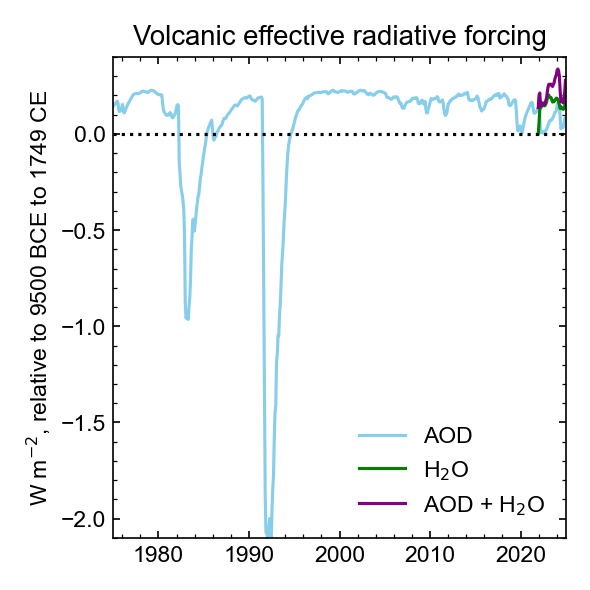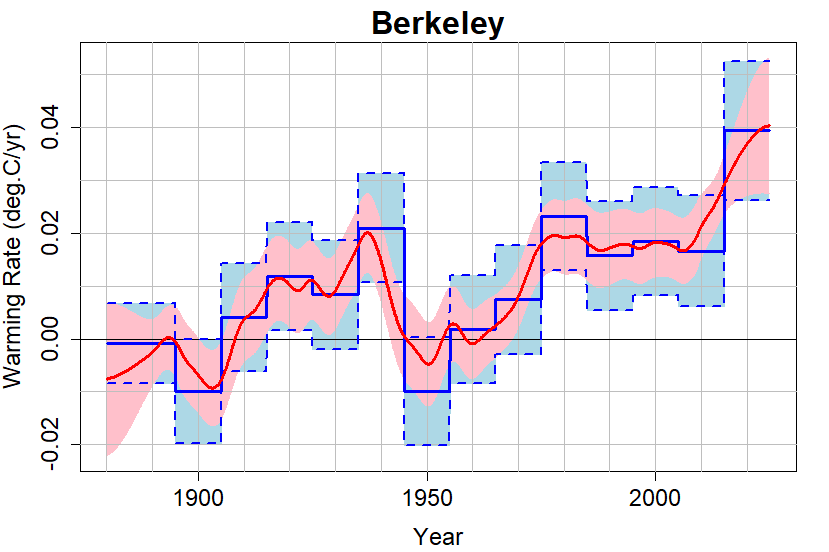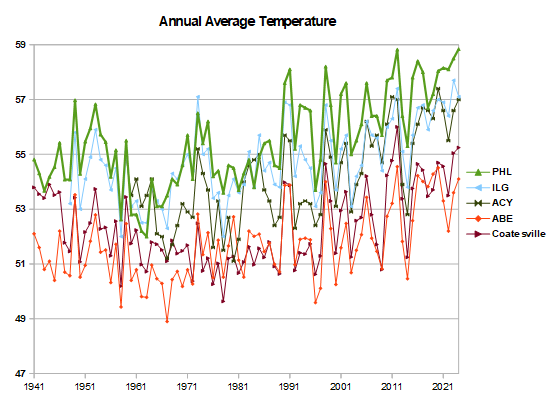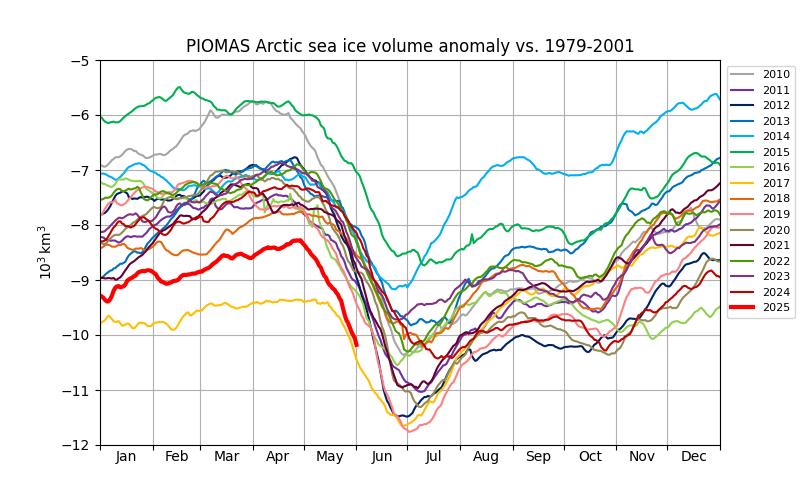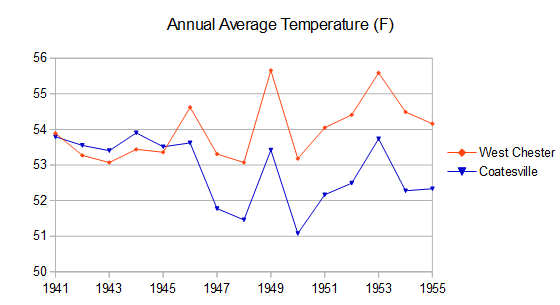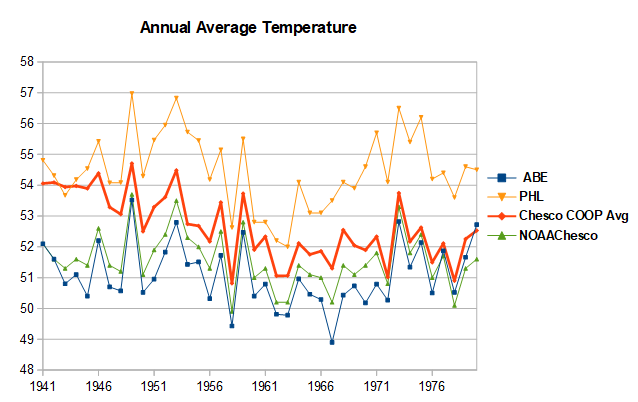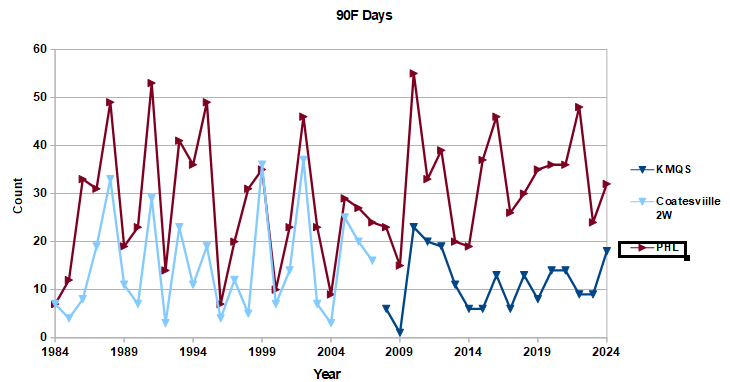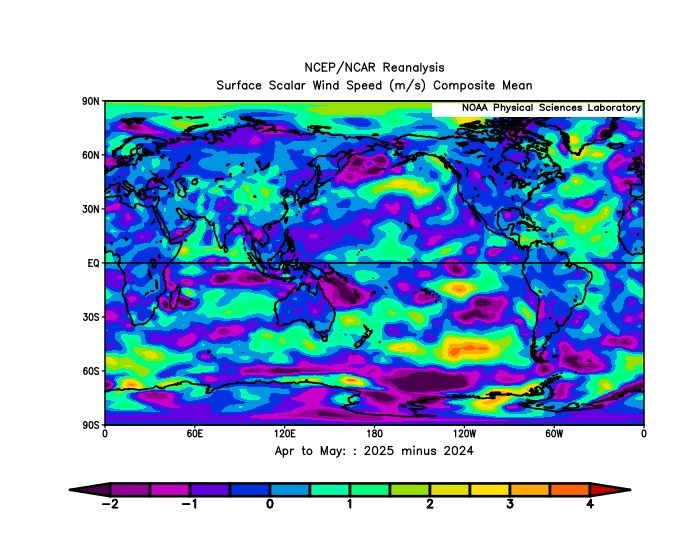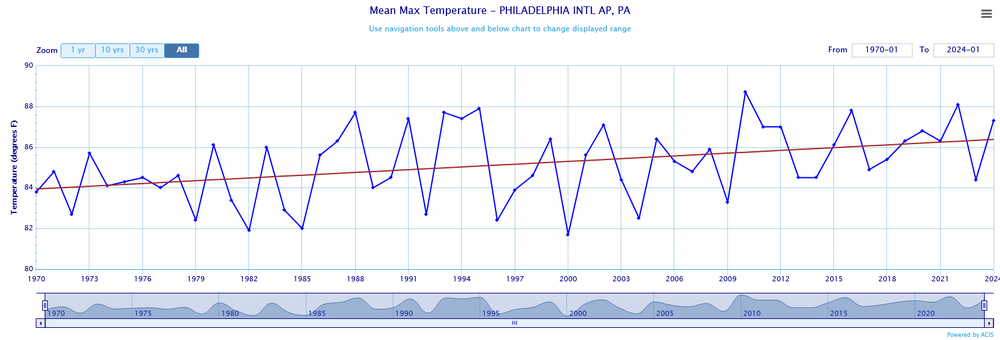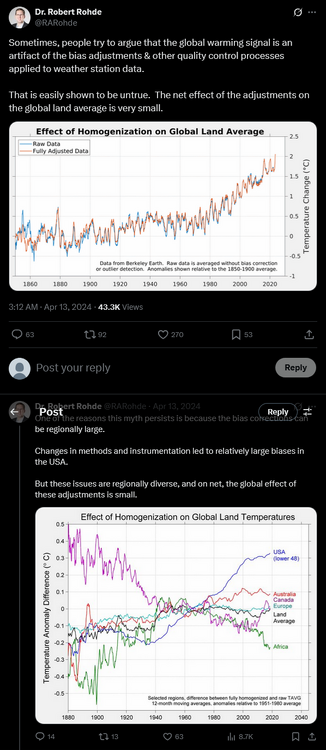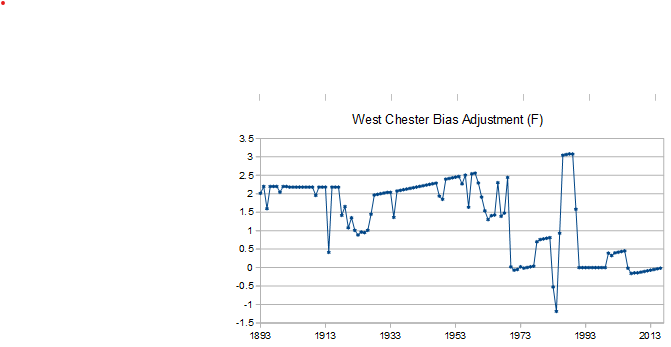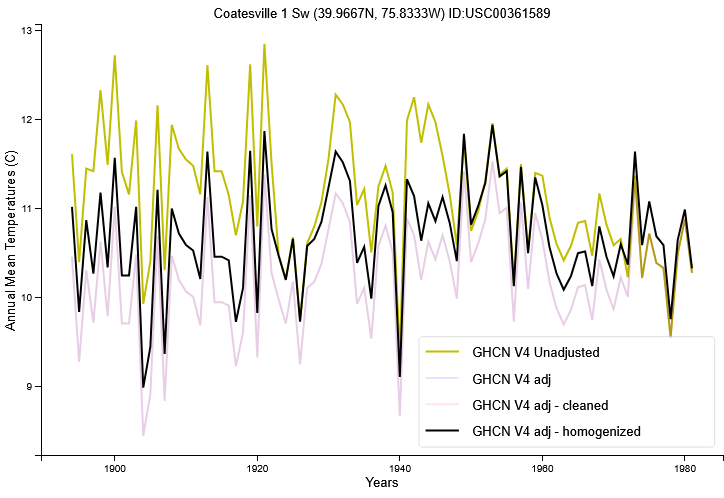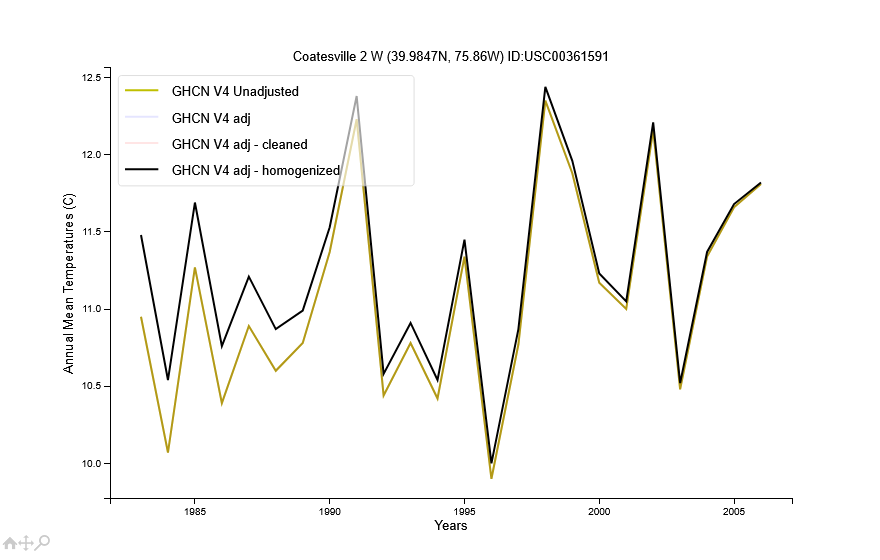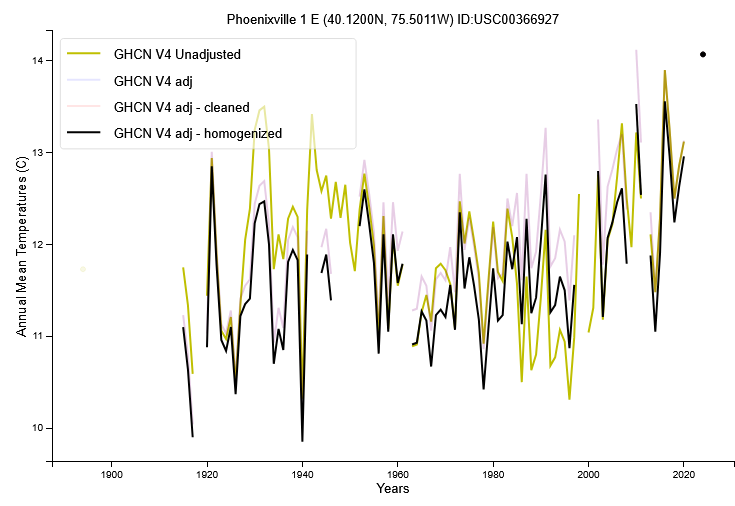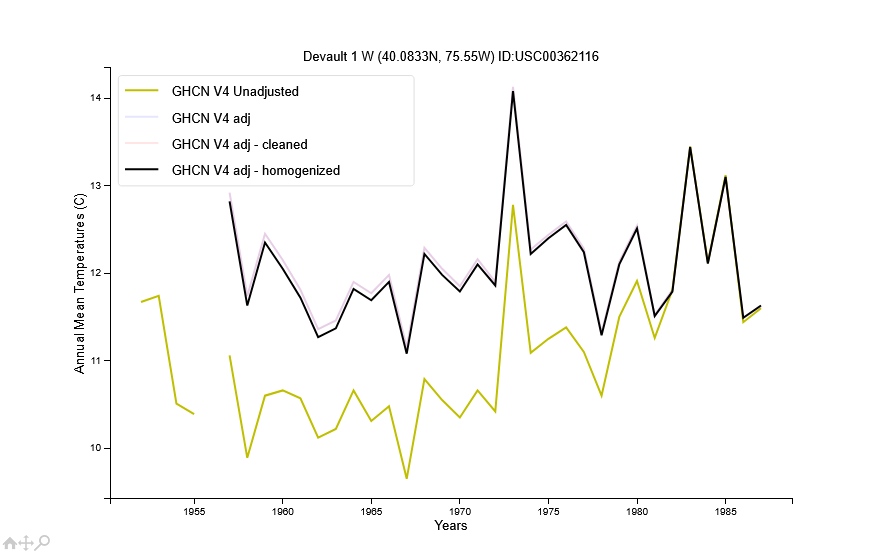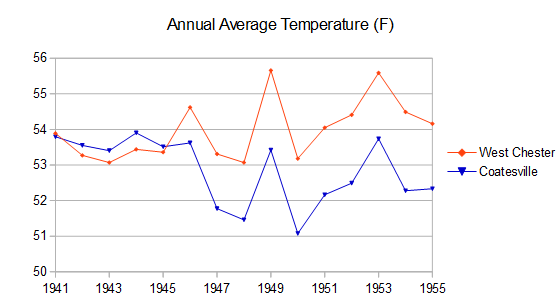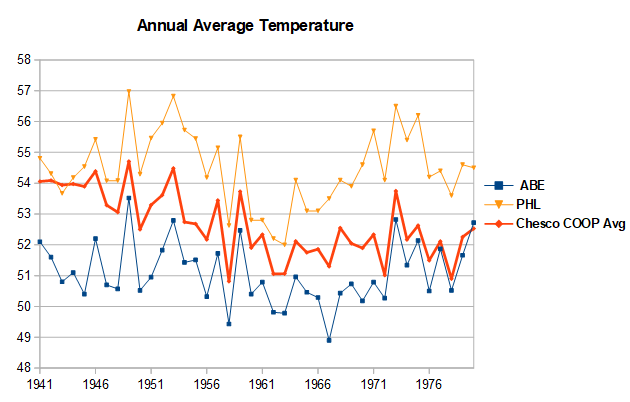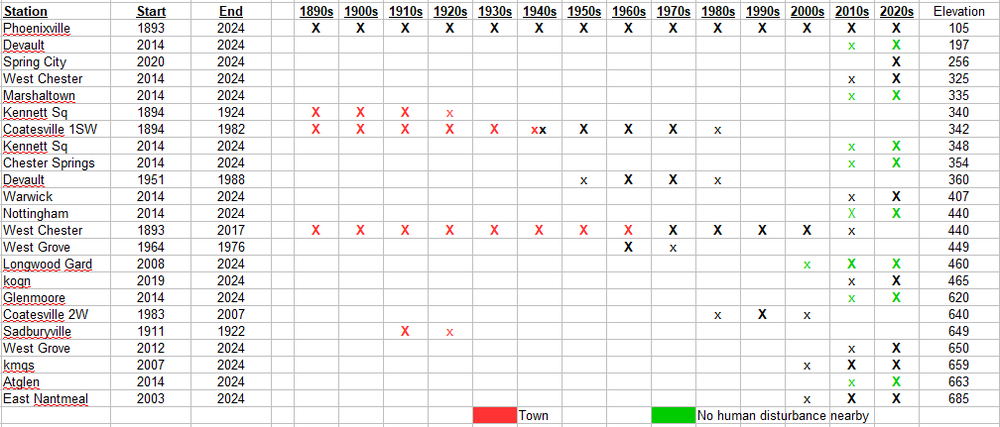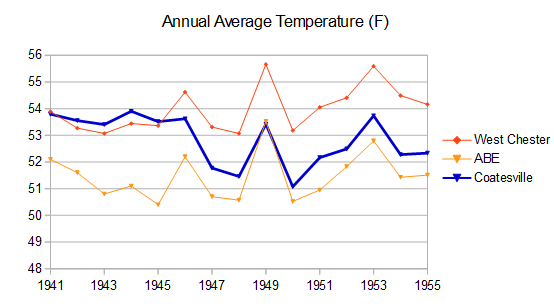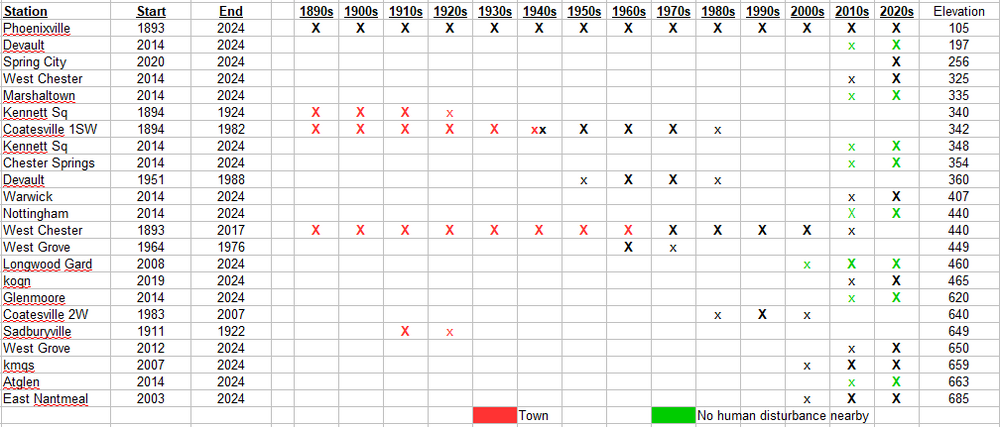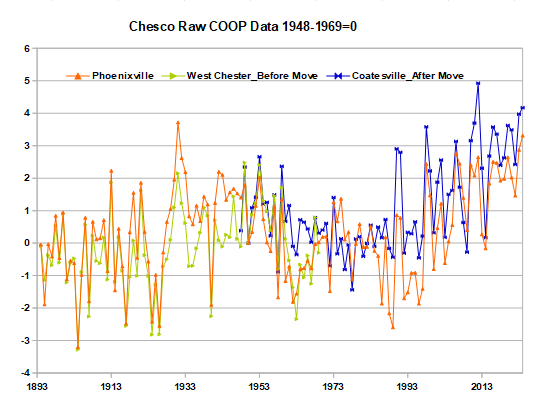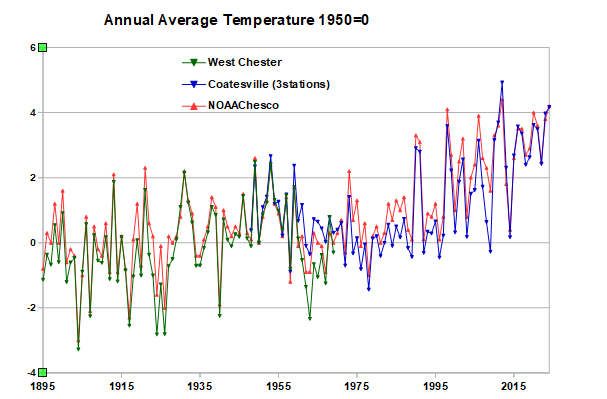
chubbs
Members-
Posts
3,920 -
Joined
-
Last visited
Content Type
Profiles
Blogs
Forums
American Weather
Media Demo
Store
Gallery
Everything posted by chubbs
-
Chester County PA - Analytical Battle of Actual vs. Altered Climate Data
chubbs replied to ChescoWx's topic in Climate Change
The Chester County deep-dive has shown that a county station average is a terrible way to evaluate NOAA. The available stations aren't designed to produce county averages by simple averaging and the stations change with time. The average shelf life of a coop station isn't very long. Even stations with long-term records have station moves and equipment changes. The NOAA method is well proven for getting the right answer from a constantly changing station network. If the stations didn't change then simpler methods would also work; but, as we have seen in Chester County the simpler methods breakdown when there are large changes in the station network with time. -
An interesting study that helps explain other recent findings. Plain Language Summary Analysis of satellite observations shows that in the past 24 years the Earth's storm cloud zones in the tropics and the middle latitudes have been contracting at a rate of 1.5%–3% per decade. This cloud contraction, along with cloud cover decreases at low latitudes, allows more solar radiation to reach the Earth's surface. When the contribution of all cloud changes is calculated, the storm cloud contraction is found to be the main contributor to the observed increase of the Earth's solar absorption during the 21st century. The paper also discusses the causes. An important contributing factor is a shift of clouds polewards in part due to Hadley Cell expansion. https://agupubs.onlinelibrary.wiley.com/doi/10.1029/2025GL114882
-
Another paper in the high climate sensitivity camp. This paper says that low-climate sensitivity models can't match CERES satellite radiation measurements, i.e. climate models are underestimating warming on average. "The CERES satellite measures Earth's energy imbalance—specifically, how much solar radiation is absorbed compared to how much heat (longwave) radiation is emitted back into space. The data show a significant increase in absorbed solar radiation, partly due to reduced snow and ice cover, but also because of changes to clouds. At the same time, Earth is emitting more heat, driven by rising surface temperatures. The satellite measurements have been compared with results from 37 climate models. The study shows a clear connection between climate sensitivity in the models and the ratio between increased absorbed solar radiation and increased heat radiation from Earth. Climate models with low climate sensitivity show small changes in the energy imbalance in the individual contributions from absorbed solar radiation and increased terrestrial radiation from Earth, and are less able to reproduce what is measured from satellite data." https://phys.org/news/2025-06-climate-sensitivity-greenhouse-gases-align.html https://www.science.org/doi/10.1126/science.adt0647
-
New paper analyzing the flowering date of Kyoto Cherries. Warming began to impact cherry flowering around 1890. Per the paper, urbanization and changes in cultivation are unlikely to have had much impact at that time. https://nph.onlinelibrary.wiley.com/doi/10.1111/nph.70268
-
Solar by the numbers. The solar age is here. https://aukehoekstra.substack.com/p/the-coming-solar-era-in-numbers
-
No I haven't changed my views. Here's an estimate of volcanic forcing through the end of 2024. Sulfur from HT has decreased faster than H2O, so the current impact of HT has changed from neutral to warming, but the effect is small, and partially balanced by a small volcano last year. Note that there has been a slight increase in volcanic activity in the past 5 years. So volcanoes would be producing a slight cooling without the HT water vapor.
-
Blog article by Tamino on paper using statistics to determine if warming has accelerated. The paper is being revised in response to peer review comments. The updated statistics estimate that the warming rate has roughly doubled in the past decade. We are have received 2 decades of warming in the past decade. Tamino notes that some slowing off this spike should be expected. https://tamino.wordpress.com/2025/06/08/picking-up-speed/#more-12598
-
You have Chester County as warm as Philadelphia in 1942. That's your UHI problem. Other local data warms in line with Philadelphia. including Coatesville after its 1946+47 station moves. Chester County only had 3 stations in the 1930s, 40s and 50s. Two of them, Coatesville in 1946+47 and West Chester in 1970, had station moves from town---> rural that produced roughly 2F cooling. Since you aren't correcting for station moves and network changes you are baking a reverse heat island effect into your calculations. Surprised a heat island expert like yourself, can't understand that.
-
Nope, I was just matching the years when you claimed the Philadelphia Airport was having a big heat island effect. I am happy to go further back. I extended my chart back to 1941, the origin of temperature data collection at the Philadelphia airport. The Philadelphia airport matches Coatesville fairly well until the big Coatesville station moves in 1946 and 1947, whose effect is clearly seen. Before the station moves, the Coatesville station was located in a built up section of the City of Coatesville. Roughly as warm as the Philadelphia Airport. Not representative of Chester County. The big heat island effect on this chart is in Chester County not Philadelphia. The reverse heat island due to the Coatesville station move to a more rural location. The West Chester station experienced a similar move to a cooler, less built-up, location in 1970. The 1970s are cool in your chart because of faulty analysis. If you correct for the station moves and other network siting changes over the years, like NOAA does, the 1970s don't stand out as a cool decade. Funny that you complain about heat island effects in Philadelphia but ignore them in Chester County.
-
Melting picked-up in May allowing 2025 to close the gap with the lowest year, 2017. Melt was focused in the peripheral areas and the Atlantic front under an AO+ regime. Need the favorable AO+ regime to persist to avoid a low year.
-
Chester County PA - Analytical Battle of Actual vs. Altered Climate Data
chubbs replied to ChescoWx's topic in Climate Change
Your in denial mode. These two charts fit together well. The station moves at Coatesville and West Chester produce spurious cooling if they are left in the raw data. That's why NOAA matches raw data without station moves and you (COOP station avg) don't. You have Chester County as warm as the Philadelphia airport before the station moves. How silly is that. -
Coatesville 2W has more 90F days than kmqs. That's the reason for the Chesco decrease. Easy to see when you separate the stations. Looks like the Philadelphia heat island extends all the way to rural Chester County.
-
I missed the Atlantic focus. One factor in cooling the tropical Atlantic are higher surface wind speeds this year vs last.
-
Agree that 100+ days are not increasing locally, but average summer temperatures are. Below are monthly temperature trends for the Philadelphia airport (PHL) and for Coatesville, Chester County in the far N+W burbs from 1970 to 2024. As you say the winters are warming the fastest, but all months are warming. Added a chart for philadelphia airport average summer high temperature. Summer highs are increasing, although nights are warming the fastest as expected with GHG.
-
What I would expect coming out of a nino. The ocean is cooling overall and the warm anomalies are migrating away from the tropics.
-
A reminder that adjustments to temperatures in the US, 6% of the world, don't matter. https://x.com/RARohde/status/1779044943501152416
-
Shewchuk is telling us something we already know: raw COOP data in the US is biased. We've known this for decades. Deniers have been making the same complaint for decades; but they haven't provided a single document in a scientific forum to back up their claims. As we have found out in Chester County, NOAA's adjustments are completely justified. Stations moved, sensors/shelters ran warm, etc. Every time we checked, the raw data at nearby stations verified the adjustment. At this point you might as well complain that the sky is blue or the world is round.
-
Chester County PA - Analytical Battle of Actual vs. Altered Climate Data
chubbs replied to ChescoWx's topic in Climate Change
You are spouting conspiracy theory mumbo jumbo. The adjustments all come from the raw data. The two big moves are by far the biggest adjustments in Chester County. Completely justified as we have seen. Let's go through the adjustments in detail. The West Chester move in 1970 triggers large adjustments before the move. 70+ years of large warm adjustments that are completely justified in the raw data. The other west Chester adjustments are relatively minor. Not that when the West Chester adjustment is less than 2F in the pre-move period it is a cooling adjustment relative to the warm town baseline. Coatesville1sw is similar to Coatesville with the 1946-47 moves being the main adjustment. Again completely justified. Coatesville 2W gets a small cooling adjustment. Phoenixville gets a warm adjustment in the 1930-1950s period. Again completely justified. Other than that the adjustments are minor. Like Coatesville 2W, Devault gets a warming adjustment. The bottom-line is that the major Chesco Coop adjustments are completely justified. The other Chesco adjustments don't impact the long-term climate trend as they are: smaller, shorter duration, and go both ways. You have complained for over a year about a scientific method you don't understand. During that time you haven't provided any evidence to back up your claims. On the contrary, the County adjustments that we have looked at are all completely justified by the raw data. Coatesville and West did have major cooling moves. Phoenixville did run warm in the 1930-50s. Your complaint boils down to the fact that you don't like the answer. What about this adjustment, What about that adjustment. That doesn't move the needle. You need to look at the raw data that triggered the adjustment. Telling us that there adjustments that you don't like doesn't move the needle. Science isn't going to change because you don't like the answer. -
Chester County PA - Analytical Battle of Actual vs. Altered Climate Data
chubbs replied to ChescoWx's topic in Climate Change
We have thousands of weather stations in the US making it very easy to separate station changes from weather. Year-to-year temperature changes are correlated for hundreds of miles. If West Chester is 2F cooler one year, Coatesville will also experience similar cooling. Why? every station in Chester County and the region experiences the same weather. The effect of the Coatesville station move is very clear in the chart below. Other than the move years of 1946 and 1947, both stations have the same year-to-year temperature change. This illustrates the close correlation in the between nearby stations when there are no station changes. However Coatesville cooled significantly relative to West Chester in 1946 and 1947. Proof that a big station change occurred in that period. Station changes are permanent. The rural Coatesville Doe run location (1948 and later) is always cooler than the West Chester town location and the city of Coatesville (1945 and earlier). That's why the city of Coatesville gets an big positive adjustment every single year. Similarly before the 1970 move, West Chester always gets a large positive adjustment because it is warmer than the post move West Chester location. This isn't rocket science. Every NOAA adjustment that we have looked at has been spot on based on the raw data and other evidence. Is there something about the chart below you don't understand? -
Chester County PA - Analytical Battle of Actual vs. Altered Climate Data
chubbs replied to ChescoWx's topic in Climate Change
The thread is based on faulty analysis not faulty data. The data is complicated with numerous station changes (see table below). If you ignore the station changes, like Chescowx does, you don't get the right answer for Chester County. As an example, here's a comparison of the Chesco Coop average to Philadelphia (PHL) and Allentown (ABE). Between 1941 and 1945, the Chester County COOP stations were as warm on average as the Philadelphia airport, much warmer than Chester County as a whole. By 1970 the stations had cooled on average to the level of Allentown. The cooling corresponds to COOP station changes as the County network transitioned from built-up towns to more rural locations. The biggest changes were the Coatesville (1946+47)and West Chester (1970) moves to less built up sites. Both station cooled by roughly 2F as a result of the moves. Other changes included: Phoenixville cooling relative to other stations and new stations starting in West Grove and Devault both in less built up areas than the pre-1945 stations. NOAA is not fooled by the station changes, but Chescowx is. -
Chester County PA - Analytical Battle of Actual vs. Altered Climate Data
chubbs replied to ChescoWx's topic in Climate Change
I do have proof. I have showed it to you over and over again. It's the raw data from Coatesville or West Chester and other stations, before and after the moves. There is no need to guess or handwave. The raw data allows the effect of the moves to be determined very accurately. Per chart below the 1946 and 1947 moves cooled Coatesville relative to West Chester and Allentown (ABE). Before the moves Coatesville was close to West Chester. After the moves it was much closer to ABE. I have just pulled and plotted a few stations. NOAA's software checks thousands of stations. So there is much more proof available than what I have shown here. There could be tens or hundreds of stations that shed light on the Chesco moves. Your post demonstrates that you don't understand what NOAA does. There's nothing arbitrary about it. The raw data alone determines all the adjustments. Only stations that change their position relative to other stations get an adjustment. In the case of the big moves at Coatesville and West Chester the move effect is so large, roughly 2F, that it is impossible to miss. Very clear in the chart below. -
Chester County PA - Analytical Battle of Actual vs. Altered Climate Data
chubbs replied to ChescoWx's topic in Climate Change
Your chart isn't raw station data. It's a station network average.If the station network is changing the station average will not match raw data from a single station. Per table below, there are 3 major periods: 1893-1948 = all stations in towns and built-up areas, 1948 - 1970 = transition out of towns, 1971 - present = in suburban or rural. Your chart has spurious cooling in the transition period due to station moves and station start-ups in more rural areas. I have plotted raw data from West Chester before the move and Coatesville after the move because there is an overlap period between 1948 and 1969, which allows the stations to have a common baseline or zero point. This provides a dataset without major station changes from 1893 to present. Phoenixville also provides long-term data at a single location, albeit with periods with other station changes. That's the main difference between my chart and yours. I have taken the major station moves out and you have left them in. When the station moves are removed the pre-1948 data isn't that warm and there isn't a big drop in temperature between 1948 and 1970. -
Chester County PA - Analytical Battle of Actual vs. Altered Climate Data
chubbs replied to ChescoWx's topic in Climate Change
You shouldn't criticize something you don't understand. The charts are 100% raw data. I've merely subtracted a constant from each station to set each stations to zero at a common point in time, either 1948-1969 or 1950. That removes the differences between stations which allows the year-to-year and long-term trends to be seen more easily. The year-to-year and long-term trends are not changed by the subtraction of a constant from each year. Phoenixville and Coatesville warm by exactly the same amount either way. West Chester, at the pre-move location, shows little change in temperature either way. -
Chester County PA - Analytical Battle of Actual vs. Altered Climate Data
chubbs replied to ChescoWx's topic in Climate Change
All I am plotting is NCEI and raw coop data. Are you saying that the County COOP data are "altered alternative facts". -
Chester County PA - Analytical Battle of Actual vs. Altered Climate Data
chubbs replied to ChescoWx's topic in Climate Change
Why? Because NCEI knows how to analyze weather data and you don't. Every time I compare NCEI to Chester County raw data they look damn good. Of course you need to take out the 2 big station moves. NCEI looks even better when data from outside the county is included. The evidence is overwhelming.


